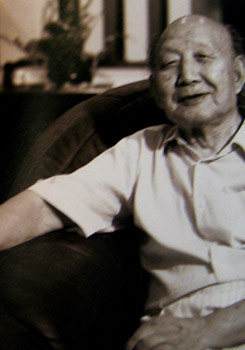|
 |
|
| |
 |
 |
 |
| |
¡@¡@Regarding
Wang, Pan-youn, you don't have to understand him
but you should know something about him. He is
thick with stories. His life might be a history
of extreme ups and downs, yet his paintings are
simple prophecies. His sun never goes down, when
the day gets dark, it will turn into the moon.
His sunset is always full of life and hangs up
on the end of the horizon. Even the heavy clouds
linger on, it still radiates and smiles. The sun
represents his anticipated but un-achievable dream.
He is like the legendary Qua Fu, pursuing the
sun and never giving up. At least, on his canvas,
his sun is always shining.
¡@¡@His solitude may be his nature
but also partly formed by his experiences. That
he enjoys being alone is not because he finds
an escape in a lonely corner but because he is
more comfortable on his own. His fate makes him
a solitary person, yet it also helps him to have
a broad horizon: no boundaries, no limitations,
just wide open space. He is the only friend to
himself. His paintings are like a mystery, difficult
for people to decipher. He uses the emptiness
to create distances. Between the said and unsaid,
between the being and non-being, one may find
the passions of sweats and tears. |
|
 |
| |
|
¡@¡@"One is not qualified
to talk about life if one hasn't tasted bread
with tears in the eyes." The thorough understanding
of life comes from hardships and destitution.
The way in which Wang cherishes his memories is
not dissimilar he cherishes his paintings. He
was born a second son of a rich family but he
lost his parents at a young age. An orphan struggling
in the crevices of a big family, he has nothing
to do with the wealth surrounding him and needs
to make his own living. Encountering human weakness
and difficulties at an early age, he becomes stronger
and stronger. He is gifted with an artistic eye
and skills. Painting is his sky that he can fly
in. Wang firmly holds his brushes and makes his
life colorful. He was educated in Shanghai Art
Academy and learned his sketches well. His paintings
seem always simple, transforming and melancholic.
While he has no expectations of wealth on hand,
not enough money for tuitions, no way to go back
to his hometown, his paintings have become even
simpler and more reserved, just like his silence.
Not being able to fulfill his dream of studying
in France, he came to Taiwan at the age of thirty-eight
as the Nationalist party was defeated by the communist.
This is another turbulent page on his life. Hardships
are inevitable when one confronts the upheavals
of an epoch and the social turbulence. He only
talks through his paintings, arguing with the
Almighty and glancing at the sun.
¡@¡@He lives a secluded life
in Lan Yang Plains for more than fifty years.
His tragedy and his pride both originated from
his paintings. When he had his first exhibit in
1966, his 32 watercolor paintings were all bought
by foreign collectors. People who really understand
his paintings are not restricted by borders. His
tragic character is projected into an internalized
metaphor, which makes his paintings imbued with
a strong sense of the modern. "My way of
thinking is ahead of our time for half a century.
I have unique acumen for colors." His surrealist
composition with minimalist touch in a very idiosyncratic
language creates the painting of his own style,
the dimensions are vivid and various. Most of
all, they are mixed with the Eastern mystic aura,
literary mind and Western modern strokes.
¡@¡@In Wang's difficult life,
he always searches for the perfect. Although the
perfect is like the sun, which is unattainable,
he is full of energy and impulse. Just like Don
Quixote, he bravely embraces his dreams and pursues
his task. In recent years, Wang, though in his
nineties, takes the challenge of painting the
work of no. 100. His touches are delicate and
subtle; his colors are radiant and warm. They
demonstrate different kind of attractions. After
all, good work will not be ignored. He might leave
the world behind but the world would not leave
him alone. The map of Taiwan art world would not
be complete without his existence.
The Artist's Own Words
¡@¡@"If you are a painter,
you'll be a painter no matter how the world changes."
That is what Gustave Moreau told Raoul Dufy. It
also reveals what Wang thinks. He believes that
life is a temporary sojourn. Everybody is like
a passenger in each other's lives. We should not
spend much time on trivia. If he has an instant
to breathe, he will not hesitate to hold onto
his brushes. Paintings are his diary. He keeps
his sorrows, his thoughts, his escapes and his
pain in his paintings. However, he will not tell
his stories directly, all the joys and sadness
are hidden in the simple images. In the wild space,
you may find his never-ending searches that induce
you to look for something meaningful but hard
to grasp. Perhaps some people find them obscure,
mysterious, or difficult to approach. But he does
not care about what people think of him. He has
painted what he wants. As his motto goes, "I
like to leave more empty space to the paintings.
I like to leave more space to what I said. I like
to reflect and meditate, not always competing¡K." |
|
| |
|
| |
|
 |
|
| 1912 |
Born in
the Village of Hsu Jia Hung in the north of
the Jiang-su Province. |
| 1914 |
Lost his
father. |
| 1924 |
Transferred
to the public school as a fourth grader.
Attended to a private village school and liked
writing calligraphy and painting when he had
free time. |
| 1926 |
Passed the
entrance exam to middle school after graduating
from elementary school.
His uncle, however, refused to pay for his
tuition, so he was not able to go to middle
school. His mother, who had been his only
support, died that year. |
| 1927 |
Studied at
the Huai An Middle School . |
| 1930 |
Permitted
to go to the high school of the Huai An Middle
school directly without having to take
another entrance exam. |
| 1933 |
Transferred
to the Department of Western Art in the Shanghai
Academy of Art. |
| 1936 |
During his
last semester at the academy, Wang became
infected with typhus and was sent to the
Shanghai Red Cross Hospital. At such a moment,
chance encounter Miss Ji Zhu-jun, who was
studying at the National Academy of Music.
After graduating from the Academy of Art,
Wang Pan-youn made an agreement with Ji Zhu-jun
to go to France to study art with Professor
Pan Yu-liang. So he went back to his hometown
to try to raise money for his trip by demanding
his share of the family property. |
| 1937 |
The Lu-gou
Bridge Battle soon exploded. Wang Pan-youn,
who had been in his hometown in
Jiang-su. |
| 1946 |
After passing
through many places, Wang arrived at Zhen-jiang
and started to teach at the Dan-Yang Middle School. |
| 1947 |
Went to Shanghai.
But as the civil war continued to rage, he
could not find a place to
live and temporarily had to stay in a refugee
camp. |
| 1948 |
Married Ni
Yue-ching. |
| 1949 |
June, the
family arrived at Kaohsiung Harbor of Taiwan
by ship. They first settled at Feng-shan. |
| 1952 |
Started teaching
at the Luo Dung High School. |
| 1961 |
Organized
the "Lan Yang Painting Association"
with eight other painters. |
| 1964 |
He met several
artists such as, Li De, Max Liu , and Pang
Zeng-ying. |
| 1973 |
Applied for
retirement on the grounds. |
| 1979 |
Invited to teach Chinese painting at the Youth
Corp Activity Center of I-lan. |
| 2017 |
Passed away at age 105. |
| |
|
| Awards
- |
| 2001 |
The Fifth "National Award for Arts of Taiwan", Taiwan. |
| 1983 |
"The Golden Rank award " by the Painting Association of the Republic of China, Taiwan. |
| 1969 |
Received
an award for best teacher. |
| |
|
| Solo
Exhibitions - |
| 2018 |
"By the Passing of a Thousand Sails- The Paintings of Wang Pan-Youn", National Museum of History, Taipei, Taiwan. |
| 2015 |
"Symbol & Singification-the Bitter Aesthetic of Wang Pan-Youn", Yilan Museum of Art, Yilan, Taiwan. |
| 2014 |
"The Sun Never Sets", Metaphysical Art Gallery, Taipei, Taiwa. |
| 2001 |
"In Pursuit of Solar Perfection" and published the volume ¡uPaintings of Wang
Pan-youn a Self-Selection¡v, National Museum of History, Taipei, Taiwan.
"Paintings of Wang Pan-youn' Selection¢w¢wNine
suns"and
republished¡mIn Pursuit of Solar Perfection¡ÐA
Play by Heaven¡n, Metaphysical Art Gallery, Taipei, Taiwan. |
| 1996 |
"Not just Loneliness", and published second volume "Paintings of Wang Pan-Youn-- The Play of God", Metaphysical Art Gallery, Taipei, Taiwan. |
| 1994 |
"Being Alone Is not Lonely", and published the volume "Paintings of Wang Pan-Youn--The Play of God", Metaphysical Art Gallery, Taipei, Taiwan. |
| 1993 |
"Wang Pan-Youn", Taiwan Museum of Art, Taichung, Taiwan. |
| 1992 |
"Wang Pan-Youn", Eslite Gallery, Taipei, Taiwan. |
| 1987 |
"Wang Pan-Youn", National Museum of History, Taipei, Taiwan.
"Wang Pan-Youn", Crown Art Center, Taipei, Taiwan. |
| 1986 |
"Exhibition of ink and water paintings", Hsiung Shi Gallery, Taipei, Taiwan. |
| 1983 |
"Exhibition of colorwater paintings", Ming Ren Gallery, Taipei, Taiwan. |
| 1979 |
"Wang Pan-Youn", Chuen Zhi Gallery, Taipei, Taiwan. |
| 1966 |
"Wang Pan-Youn", International Gallery, Taipei, Taiwan. His thirty-two watercolors were all sold to a group of Americans. |
| |
|
| Group
Exhibitions - |
| 2019 |
"Art Central Hong Kong", Metaphysical Art Gallery, Hong Kong.
"Beside the Window", Metaphysical Art gallery, Taipei. |
| 2018 |
"Youth Unlimited", Metaphysical Art Gallery, Taipei, Taiwan. |
| 2017 |
"Ala Aureus" Taipei Art Fair International, Taipei, Taiwan. |
| 2016 |
"Look Up Rose from the Sky", Metaphysical Art Gallery, Taipei, Taiwan. |
| 2015 |
"Absolute Intuition" / "Post-objectivity", Metaphysical Art Gallery, Taipei, Taiwan.
|
| 1997 |
"Taipei Art Fair International", Taipei, Taiwan. |
| 1989 |
"Contemporary Artistic Development", National Museum of History, Taipei, Taiwan. |
| 1988 |
"Opening Exhibition of Taiwan Museum of Art", Taichung, Taiwan. |
| 1985 |
"Asian International Art Fair" , Korea. |
| 1983 |
"Opening Exhibition of Taipei Fine Arts Museum", Taipei, Taiwan. |
| |
|
Collections - |
Taipei Fine Arts Museum, Taipei, Taiwan. |
National Museum of History, Taipei, Taiwan. |
Taiwan Museum of Art, Taichung, Taiwan. |
|
|
|
|
| |
|
|







